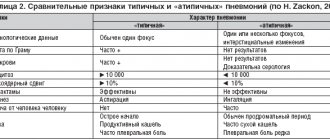Azithromycin in the treatment of community-acquired pneumonia
Sarygina O.D.
Community-acquired pneumonia (synonyms: home, outpatient) is an acute disease that arose in a community setting, accompanied by symptoms of lower respiratory tract infection (fever, cough, chest pain, shortness of breath) and “fresh” focally infiltrative changes in the lungs in the absence of obvious diagnostic alternatives.
Community-acquired pneumonia (CAP) can be divided into 3 groups:
- Pneumonia that does not require hospitalization. This group of patients is the largest, accounting for up to 80% of all patients with pneumonia; these patients have mild pneumonia and can receive therapy on an outpatient basis; mortality does not exceed 1-5%.
- Pneumonia requiring hospitalization of patients in a hospital. This group makes up about 20% of all pneumonias; patients have underlying chronic diseases and severe clinical symptoms; the risk of mortality in hospitalized patients reaches 12%.
- Pneumonia requiring hospitalization of patients in intensive care units. Such patients are defined as patients with severe community-acquired pneumonia. The mortality rate for severe pneumonia is about 40%.
The reasons for the development of an inflammatory reaction in the respiratory parts of the lungs can be either a decrease in the effectiveness of the body’s defense mechanisms, or a massive dose of microorganisms and/or their increased virulence. Aspiration of the contents of the oropharynx is the main route of infection of the respiratory parts of the lungs, and therefore the main pathogenetic mechanism for the development of pneumonia. Under normal conditions, a number of microorganisms (eg, Streptococcus pneumoniae) can colonize the oropharynx, but the lower respiratory tract remains sterile. In cases of damage to the “self-cleaning” mechanisms of the tracheobronchial tree, for example, during a viral respiratory infection, favorable conditions are created for the development of pneumonia. In some cases, an independent pathogenetic factor may be the massive dose of microorganisms or the penetration into the respiratory parts of the lungs of even single highly virulent microorganisms that are resistant to the action of the body’s defense mechanisms, which also leads to the development of pneumonia.
The etiology of CAP is directly related to the normal microflora colonizing the upper respiratory tract. Of the numerous microorganisms, only a few that have increased virulence are capable of causing an inflammatory reaction when they enter the lower respiratory tract.
Such typical pathogens of community-acquired CAP are: Streptococcus pneumoniae, Haemophilus influenzae.
Atypical microorganisms have a certain significance in the etiology of community-acquired CAP, although it is difficult to accurately determine their etiological significance: Chlamydophila (Chlamydia) pneumoniae, Mycoplasma pneumoniae, Legionella pneumophila.
Typical but rare pathogens of CAP include: Staphylococcus aureus, Klebsiella pneumoniae, and less commonly, other enterobacteriaceae.
Streptococcus pneumoniae is the most common causative agent of CAP in people of all age groups. Due to the difficulty of identifying the pathogen, initial therapy for CAP in the vast majority of cases is empirical. The choice of drugs is based on data on the frequency of occurrence of certain pathogens in different age groups, the local level of antibiotic resistance, the clinical picture of the disease and epidemiological information.
The initial choice of an antimicrobial drug is made empirically (i.e., before receiving the results of a microbiological study), since:
- at least in half of the cases the responsible microorganism cannot be identified even using the most modern research methods, and existing microbiological methods are rather nonspecific and insensitive;
- any delay in etiotropic treatment of pneumonia is accompanied by an increased risk of complications and mortality of pneumonia, while timely and correctly selected empirical therapy can improve the outcome of the disease;
- assessment of the clinical picture, radiological changes, concomitant diseases, risk factors and severity of pneumonia in most cases allows making the right decision on the choice of adequate therapy.
At the same time, it is necessary to strive to clarify the etiological diagnosis, especially in patients with severe pneumonia, since such an approach may have an impact on the outcome of the disease. In addition, the advantages of targeted therapy include a reduction in the number of drugs prescribed, a reduction in the cost of treatment, a reduction in the number of side effects of therapy, and a decrease in the potential for the selection of resistant strains of microorganisms.
The choice of initial therapy depends on the severity of the disease, site of therapy, clinical and epidemiological factors. Since it is often difficult to immediately determine the type of causative agent of CAP, macrolides, which have a wide spectrum of antimicrobial action, are widely used drugs.
As an analysis of foreign data shows, macrolides are effective in 80-90% of patients with CAP. This is determined by their adequate spectrum of activity, including most potential pathogens, incl. mycoplasma, chlamydia and legionella, as well as favorable pharmacokinetic properties that lead to the creation of high concentrations in the lungs. An important factor determining the empirical choice of macrolides is the low level of resistance of a number of microorganisms to them. For example, mycoplasmas exhibit constant sensitivity to antibiotics of this group; the development of resistance to them has not been described. In Russia, the level of macrolide resistance of the most common causative agent of CAP, S. Pneumoniae, is less than 5%. Moreover, in a number of microorganisms, sensitivity to macrolides was restored after a period of decreased intensity of their use.
The advantages of macrolides also include low toxicity and good tolerability, including low allergenic potential. The frequency of hypersensitivity reactions when used does not exceed 0.5%, which is significantly lower than that during treatment with penicillins (up to 10%) and cephalosporins (up to 4%), and therefore macrolides are considered the drug of choice in patients with allergies to 3-lactam antibiotics .
North American guidelines for the treatment of CAP consider macrolides as first-line drugs. Their effectiveness and safety are confirmed by the results of a meta-analysis of clinical studies.
It is suggested that macrolides not only have a therapeutic effect, but also help prevent carriage of atypical pathogens, which can lead to a decrease in the frequency of recurrent cases of PAP and a decrease in morbidity.
The above factors determine the widespread use of macrolides in adults and children for lower respiratory tract infections, starting in 1952, when the first representative of this pharmacological group, erythromycin, appeared on the international pharmaceutical market. In subsequent years, new antibiotics from the macrolide group were developed, differing from erythromycin primarily in improved pharmacokinetic properties and better tolerability.
The most widely used among modern macrolides is azithromycin. More than 20 years of experience in the use of azithromycin in clinical practice indicates its truly worldwide recognition. During this time, the drug has proven itself in the treatment of various infectious diseases, and primarily bronchopulmonary infections. According to the results of a study by the European Society of Antimicrobial Chemotherapy (ESAC), conducted in 2001-2002, in most European countries, macrolides rank second in terms of consumption among antibiotics used in outpatient practice, second only to penicillins. Azithromycin and clarithromycin are among the “top five” most actively sold antimicrobial drugs in the world. Consumption of azithromycin reaches colossal volumes and continues to increase steadily. In 1999, azithromycin was the most prescribed macrolide drug in the world (IMS Drug Monitor, 1999), with sales exceeding US$1 billion in 2002.
Features of azithromycin compared to other macrolides
Azithromycin (Zitrocin) is a semisynthetic antibiotic from the group of 15-membered macrolides or azalides. This chemical structure determines its improved pharmacokinetics, primarily significantly increased acid resistance (300 times compared to erythromycin), better absorption from the gastrointestinal tract and more reliable bioavailability. The features of azithromycin that distinguish it from other macrolides are its very long half-life (up to 79 hours) and the ability to create higher concentrations in tissues. Azithromycin is superior to other macrolides in its ability to accumulate intracellularly. It is actively captured by phagocytes and delivered to foci of infectious inflammation, where its concentrations are 24-36% higher than those in healthy tissues. The ability of azithromycin to penetrate phagocytes is 10 times higher than that of erythromycin.
Due to its high lipophilicity, azithromycin (Zitrocin) is well distributed throughout the body, reaching levels in various organs and tissues that far exceed the minimum inhibitory concentrations (MIC) for the main pathogens of the corresponding localization. Intracellular concentrations of the drug are 10-100 times higher than those in blood plasma. The highest concentrations are created in the tonsils, adenoids, middle ear exudate, bronchial mucosa and bronchial secretions, as well as in the epithelium of the alveoli. A high level of the drug in the bronchi and lungs is maintained for several days after its discontinuation. The spectrum of action of azithromycin is wider than that of erythromycin, due to microorganisms such as Borrelia burg-dorferi, Helicobacter pylori, the intracellular complex of Mycobacterium avium, Cryptosporidium spp. and Toxoplasma gondii. The activity of azithromycin against gram-positive microorganisms is comparable to that of erythromycin, but it is superior to erythromycin in its activity against gram-negative microorganisms in vitro. In particular, azithromycin is 2-8 times more active than erythromycin against H. influenza, including 3-lactamase-producing strains, which occur in approximately 20-40% of cases. Azithromycin is superior to erythromycin in activity against Legionella spp., H. ducreyi, Campylobacter spp. and some other microorganisms. The drug acts on all major pathogens of lower respiratory tract infections, including S. pneumoniae, H. influenzae, M. catarrhalis, M. pneumoniae and C. pneumoniae. According to Japanese authors, azithromycin remains active against pneumococci resistant to other macrolides.
Azithromycin (Zitrocin) has a post-antibiotic effect, incl. against such pathogens of community-acquired pneumonia as S. pneumoniae and H. influenzae.
The advantage of azithromycin over other macrolides, as well as most antibiotics of other groups, is a once-daily dose and a short course of treatment, which is convenient for both children and their parents. A convenient regimen of administration, in turn, increases the accuracy of following therapeutic recommendations.
The advantages of azithromycin include high safety and good tolerability, due to both a favorable adverse reaction profile and a low potential for clinically significant drug interactions. According to the results of meta-analyses, the rate of discontinuation of azithromycin due to adverse reactions is 0.7% for lower respiratory tract infections and 0.8% for upper respiratory tract infections. The discontinuation rate of comparison antibiotics according to the results of these meta-analyses was for amoxicillin/clavulanate - 2.3-4%, cefaclor - 1.3-2.8%, erythromycin -1.9-2.2%, clarithromycin - 0.9 -1%. In clinical studies, azithromycin rarely caused serious adverse reactions, the cause-and-effect relationship of which with the drug has not been fully established.
The ability of macrolides to enter into drug interactions is primarily determined by their effect on enzymes of the cytochrome P450 system in the liver. According to the degree of inhibition of cytochrome P450, they are arranged in the following order: clarithromycin > erythromycin > roxithromycin > azithromycin > spiramycin. Thus, with regard to drug interactions, azithromycin (Zitrocin) is safer than most other macrolides. Unlike erythromycin and clarithromycin, it does not interact clinically with cyclosporine, cisapride, pimozide, disopyramide, astemizole, carbamazepine, midazolam, digoxin, statins and warfarin.
Azithromycin (Zitrocin) is recommended to be taken before meals, since under the influence of food its bioavailability, according to some data, may decrease. However, 3 studies showed that food did not affect the bioavailability of azithromycin in dosage forms such as 250 mg tablets, 1000 mg powders and 500 mg pediatric suspension [49]. The results of these studies indicate that taking azithromycin (Zitrocin) does not need to be tied to meals, which makes the use of the drug even easier.
Thus, the main properties of azithromycin, which allow it to maintain a strong position in the treatment of not only community-acquired pneumonia, but also other respiratory tract infections, come down to the following:
- high activity against the main pathogens of lower respiratory tract infections (S. pneumoniae, H. influenzae, M. catarrhalis, S. aureus, Enterobactericae);
- activity against intracellular atypical pathogens;
- low resistance of S. pneumoniae and H. influenzae to azithromycin;
- high concentration in various bronchopulmonary structures;
- the presence of a post-antibiotic effect;
- absence of clinically significant interactions with other drugs;
- convenient dosing regimen;
- availability of the drug in various dosage forms.
In the modern extensive arsenal of antibacterial drugs intended for the treatment of bronchopulmonary infections, azithromycin continues to occupy an important place.
Causes of persistent cough
Before choosing a behavioral tactic and a possible treatment method, it is necessary to exclude diseases, the symptom of which may be a lingering cough. Among them are pneumonia, bronchitis, pleurisy, pharyngitis. Then you need to find out whether a lingering cough is an allergic reaction to animal hair, flowering or environmental pollution - according to the World Health Organization (WHO), any resident of a developed industrial center in some At this point, a reflex cough may appear. A lingering cough may develop in workers in hazardous industries and in smokers, including those who have recently quit. Even after completely quitting smoking, a reflex cough sometimes continues to torment a person for six months, because nicotine has irritated the cough receptors for a long time and they need time to recover. One of the common causes of a lingering cough is the restoration of the irritated mucous membrane of the respiratory tract after bronchitis or a respiratory disease . This process lasts up to a month and a half, during which any, even the most insignificant, irritant - for example, smoke or a strong smell - can lead to a coughing attack.


![Table 3. Pharmacokinetic and pharmacodynamic parameters of fluoroquinolones with a single standard dose taken orally [7, 13]](https://irknotary.ru/wp-content/uploads/tablica-3-farmakokineticheskie-i-farmakodinamicheskie-parametry-ftorhinolonov-pri-odnokratnom-prieme-330x140.jpg)




